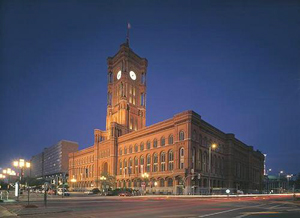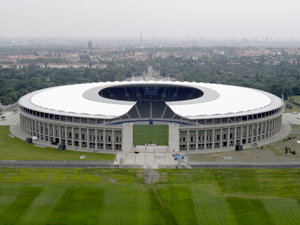
Germany 2006 FIFA World Cup VenuesFIFA World Cup Host Cities - BERLINBerlin city profile
The city became the political centre of Brandenburg, Prussia and the German Reich. After the foundation of the German Reich in 1871, the city progressed quickly to become Germany’s largest industrial and cultural centre. The Second World War (1939-1945) triggered by the National Socialists, the Nazis, had a devastating effect on Berlin and led to the destruction of large parts of the city. Subsequent political developments divided the country and its capital: The building of the Wall in 1961 drastically and brutally completed this separation. The Wall did not come down again until 1989, when the people from West and East Berlin were finally reunited. Berlin, the country’s largest city, has once again become the capital of a united Germany, the Brandenburg Gate symbolising this re-unification. Berlin is not only the seat of the government and cultural capital, but also Germany’s sports city. More than 525,000 male and female athletes are registered in about 1,900 clubs; 160 teams from Berlin compete in the top leagues in most differing sports – including football, of course. From basketball to cycling, gymnastics, ice hockey, judo, swimming to volleyball and water polo. The Olympic Training Centre Berlin is the largest in Germany. It is not just by chance that Berlin, proportionate to its size and inhabitants, is very well represented in German Olympic squads. At the 1998 Olympic Winter Games in Nagano ten per cent of the German athletes came from Berlin. Berlin has a tradition as a sports city. Not only because the first public exercise site was inaugurated as early as 1811, but also because many sporting highlights are staged here year by year. For instance the Berlin Marathon, the international athletics event ISTAF, the women’s international tennis championships, the CHI equestrian event and the Six Days in the newly built »temple« of cycling, the Velodrom. The city’s currently most successful football clubs are Hertha BSC, which plays in the Bundesliga, and Tennis Borussia Berlin in the Zweite Bundesliga. Major events at the Berlin Olympiastadion
Berlin stadium profilePopulation: 3.39 millionStadium: Olympiastadion Project: Reconstruction Investment: 242 million Euro Gross Capacity: 74,220 Total Seating Capacity: 66,021 (*) Purchasable Ticket Capacity (**)
American sprinter Jesse Owens won four gold medals here at the 1936 Olympic Games. Today, one of the avenues leading to the ground and a VIP lounge bear the great runner's name. The stadium has staged the German Cup Final since 1985. Reconstruction at a cost of €242m began in the summer of 2000. A spectacular gala opening ceremony including an appearance by world-renowned star P!NK took place on 31 July 2004. Hertha BSC Berlin contested the first match at the facelifted arena against Besiktas Istanbul on 1 August. The following month, FIFA World Cup holders Brazil met Germany in the inaugural international. Reconstruction had to be carried out with the greatest of care due to the listed status of the structure, originally designed by architect Werner March and built between 1934-36 for around 42 million Reichsmark. The new stadium incorporates VIP and Sky executive boxes, Business Seats, a Hertha BSC megastore, underground warm-up facility (including a 110m running track and long-jump pit) and an underground car park. The rebuilding project was primarily aimed at optimising functionality and spectator comfort. For example, practically all the 74,200 seats are covered, whereas previously only 27,000 seats were protected from the elements. 5,000 dimmable fluorescent lamps, an ultra-modern PA system and dazzle-free floodlighting provided by a single brilliant band along the front edge of the roof permit a wide variety of exciting atmospheric effects. The new roof, a vast oval interrupted as before by the listed Marathon Gate, provides a delicate contrast to the robust muscularity of the historic tectonics. The lightweight cantilever construction is borne by an intricate web of 20 beam supports ranging over the gallery, and 132 steel pillars. The roof is literally the crowning glory of a harmonious solution incorporating past, present and future. Financing: (*) "Total Seating Capacity" means the Gross Capacity less the seats unavailable for use due to restricted views and security/contingency reserves for the 2006 FIFA World Cup. This capacity is estimated and may change once these deductions are finally determined.
|
|||||||||||||||||||||||
Recommended Sportsbook
Bookmaker Sportsbook is a recognized sports betting leader since 1985. BookMaker provides safe, legal, and secure betting on major sporting events, as well as horse racing, casino, and poker entertainment, from any location in the world, 24 hours a day 7 days a week. Bookmaker is the number one legal online sports betting and entertainment center of America. Bonded and fully licensed by the Government of Costa Rica. With a reputation like this everyone should have an account.
Bookmaker covers all needs for any real gambler. If you do not have an account with Bookmaker you are making a very big mistake. Signing up now is better than ever as gives you the best bonuses available. With an array of bonuses and the best reputation, Bookmaker is a must have for A list sportsbook betting fans. Sign up today!
 Since its foundation it has been Berlin’s fate to be divided and re-unified. Within the confines of the Spree valley, between Koepenick and Spandau, Coelln was founded on the Spree Island and Berlin on the north bank. Coelln was first mentioned in a document in 1237. Coelln and Berlin were unified in 1307, the unification being annulled in 1442. This separation lasted until 1709.
Since its foundation it has been Berlin’s fate to be divided and re-unified. Within the confines of the Spree valley, between Koepenick and Spandau, Coelln was founded on the Spree Island and Berlin on the north bank. Coelln was first mentioned in a document in 1237. Coelln and Berlin were unified in 1307, the unification being annulled in 1442. This separation lasted until 1709.  The Berlin Olympic Stadium has hosted its fair share of momentous, epoch-making events, but 9 July 2006 is destined to eclipse everything that has gone before. A global audience of well over a billion is set to follow the 2006 FIFA World Cup Final live on TV.
The Berlin Olympic Stadium has hosted its fair share of momentous, epoch-making events, but 9 July 2006 is destined to eclipse everything that has gone before. A global audience of well over a billion is set to follow the 2006 FIFA World Cup Final live on TV.